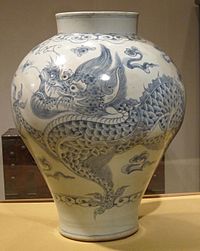- Dragon jars (Korean)
-
18th century dragon jar, with underglaze cobalt blue design, Honolulu Academy of Arts

Korean dragon jars, also known as cloud-dragon jars are a type of ceremonial porcelain vessel that became popular among the ruling classes of Korea during the Joseon Dynasty (1392–1910). They are decorated with large dragons against a background of stylized clouds, painted with underglaze pigments.
In addition to being a generally auspicious symbol, the dragon represented the authority and beneficence of the ruler.[1] In 1754, King Yòngjo decreed that iron pigments were to be used exclusively, except for jars having a dragon design.[2] Because of the scarcity of the traditional cobalt blue pigment, which was imported from Muslim Turkestan, and was also known as “Mohammedan blue”, an underglaze brown iron oxide pigment was also used between the seventeenth and nineteenth centuries.[3]
Footnotes
- ^ Gallery label, Philadelphia Museum of Art
- ^ Covell, Jon Carter & Alan Covell, The World of Korean Ceramics, Seoul, Si-sa Yong-o-sa, 1986, p. 74
- ^ Gallery label, Minneapolis Institute of Arts
Categories:- Korean pottery
- Dragons
Wikimedia Foundation. 2010.


